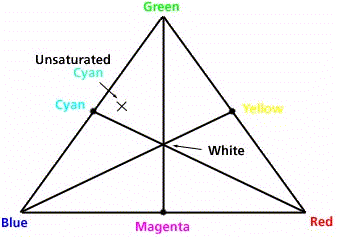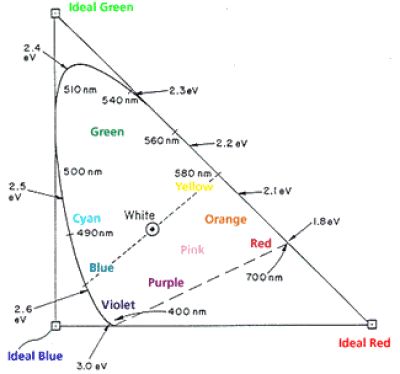

|
The sensation of color depends on the composition of light which is a mixture of white light
and colored light. The colored light could have a dominant wavelength or hue. The hue
that dominates is know as saturation (chroma). If the hue is diluted with white light, the
saturation decreases.
There are three receptors in the eye that are activated by different wavelengths. This is
why colors are charted by a mixture of three primary lights. Figure 1 is an illustration of
James Clerk Maxwell's color triangle. The three apexes represent three primary colored
lights: blue-violet, orange-red, and green. A multitude of colors can be produced by mixing
lights of the three primary colors, but not all colors. A specific color (i.e., an unsaturated
greenish blue) can be represented by a point on the triangular grid.
 FIGURE 1. Maxwell's color triangle. The apices indicate the additive primary colors. The
edges, the subtractive colors. Many but not all colors can be created by a mixture of the
three color lights. The closer a point is to an apex the greater the proportion of the light
is represented by that apex.
In order to represent all colors, three imaginary or "ideal" primaries must be used. The
Commission Internationale de l'Eclairage (CIE) in 1931 defined the chromaticity curve with
a standard observer and three ideal standard sources (modified in 1967). The chromaticity
diagram is constructed by drawing a color triangle with three ideal, but non-existent,
primary colors at each corner (See Fig. 2). The X-axis indicates the amount of ideal green
that would be mixed with blue. The Y-axis indicates the amount of ideal red that would be
mixed with blue. Values along the two axes represent a given color.
Superimposed on the triangle is the CIE chromaticity curve. It represents a band of pure
spectral colors as a solid curve from violet up to green and down to red. The broken line
connecting 380 nm and 700 nm are the non-spectral colors of purple which is obtained by
mixing violet and red light beams. All the color which a human being can see are
contained within the area bounded by the solid and broken lines. The central point at
White in the diagram is the white produced by an equal mixture of the three primary colors.
 FIGURE 2. CIE chromaticity diagram illustrating wavelengths in nanometers (nm) and
energies in electron volts (eV). The area encompassed by the curved line and broken line
segments include all visible colors. The pure spectral colors appear along the curved
edge.
A mixture of two spectral lights can be represented as a point on the line joining the light
point on the spectral curve. The broken line (Fig. 2) joins the blue light at 480 nm with
yellow light at 580 nm. Following the broken line we go from spectral (saturated) blue to
white to pale yellow to saturated yellow. A mixture of the correct amounts of 480 nm blue
light and 580 nm yellow light forms any of the colors located in between. In the same way,
purple colors can be formed by a mixture of red light with violet light as indicated on the
broken line. A pair of colors that result in white (line joining the two colors passing through
the white point) are called complementary colors. For example, blue light and yellow light
form a complementary pair as do orange (600 nm) and blue-green (cyan, 488 nm). The
mid-point (White) can be used as the origin to describe color as a mixture, in proportions
of white light of a given wavelength. This wavelength, referred to as the dominant
wavelength and the color associated with this dominate wavelength is termed the hue.
The sensation of color is described in terms of hue. The amount of hue making up the
composition of light is known as saturation (or chroma). The dominant wavelength points
on the spectral curve are shown as a solid line in Figure 2 are fully saturated. As a
dominate wavelength or hue is diluted with white light the saturation is decreased.
 FIGURE 3. Illustrates different ways of obtaining metameric beams of pink light. Each
graph indicates a mixture of white light to obtain pink light. A: shows a mixture of white
and orange. B: a mixture of red with cyan. C: a mixture of red, green, and violet. To the
human eye these metameric colors would all appear the same.
The following program shows how the computer uses the three primary colors Red, Green, and Blue to produces various shades of color. |
|
Homework Questions Source Listing |